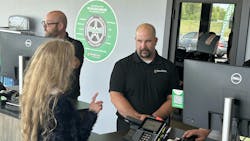Now more than ever, the American consumer feels an enormous amount of pressure. The biggest paradigm shift has been inflationary pressures on nearly every consumer product.
Gasoline is up. Electricity is up. Groceries are up. Rent is up. Even tires are more expensive than they were four years ago. As a result, consumers’ defenses are up.
But despite that, could this be an ideal time to learn new ways of up-selling your customers on replacement tires and auto repair? The obvious answer is yes.
As we look at how to up-sell customers, it is important to note that some do this right and some do it wrong — and it usually can be spotted in a few customer reviews.
In the digital age, customer reviews should be a powerful motivation for up-selling the right way — without putting pressure on the consumer. Believe it or not, there is still a lot of money that you allow to stay in your customer’s pocket that could be spent in your store and will ultimately help them.
But how does your salesman at the front counter up-sell the right way when he has objectives to hit? Here are five pragmatic tips to help up-sell without putting pressure on already-stretched customers. All five are equally important!
- You must have a process. Most people do not understand that good, correct, no-pressure up-selling starts with every customer touch point and those touch points must help you build trust. Assuming you have a great website and a great customer experience process that you execute every day and not just sporadically, you must also have an up-selling process.
Why do you need a process? The simple answer is that you will be more intentional with every customer engagement and that engagement will become memorable for your customer. They must remember that there was “no pressure” applied. Having a process will keep your people from caving to the pressures placed on them from above and separate them from the need of having to hit a goal/number at all costs. Even though you can be moderately successful without a process, you will not be firing on all cylinders without a process that helps the customer become more informed and/or educated about his or her car.
I have seen good processes and bad processes over the years. Some that are bad make customers feel like it’s all about what the tire dealership is trying to do “to” them instead of making the customer feel like it’s trying to do something “for” them. An example of this is using an unlikely, catastrophic scenario as a motivator to close the sale. (“Fix this now or your car will explode!”)
There should never be mention of a catastrophic event taking place. However, incorporating phrases like “This will help your car perform better” or “This will help extend the life of your vehicle” can be coupled with “while keeping you safe on the road.” This will make a sale more palatable to most consumers who will trust you more because they are being helped and not hurt. And this could lead to positive customer reviews that others will see.
- You must have a better understanding of the customer. If you are a salesperson at a tire store, you must assume the customers do not think like you or know what you do. Several years ago, when I was consulting for a multi-store tire dealer, a front counter salesperson did not offer a customer the option of installing a new serpentine belt even though there would be no added labor charge. When the owner of the three stores was driving the car to the customer — who was also a friend of his — the serpentine belt failed. When the counter salesperson was asked, “Why didn’t you recommend a new belt to the customer?” he answered, “The repair bill was already so expensive I did not think they would want to pay the extra money for the part.” Needless to say, in hindsight, the customer would have gladly paid if the salesperson had offered to install a new belt.
I have listened to many phone calls where customers called a tire store to complain that an add-on was not offered to them and now they were on vacation having to spend time and money getting a repair performed that their local repair shop should have mentioned. Understand that with the price tag of new cars and increased interest rates for auto loans, most of today’s customers want to make their cars last longer and are willing to pay for maintenance that’s needed.
- Never try to diagnose on the phone. I know this one sounds simple, but I have heard countless salespeople at some very successful stores tell the customer what they “think” a mechanical problem “could be.” Sometimes they will even throw a ballpark price at the customer. Most of the time they are wrong on both counts and they end up having to eat some crow and lose the customer’s trust. All of this can be avoided by getting the customer to the store and letting them know that an inspection will be performed on their car, a certified technician will inform them what needs to be fixed and they will then have the option to either approve or disapprove. Worst case scenario, you explain your diagnostic fees on the phone and let them know if or how much of this fee would be applied to their repair bill if they decide to approve the repair. This kind of interaction will almost always build trust. The salesperson should always be able to explain what the technician found and the repair they recommend.
- Refrain from being perceived as being too aggressive. Customers perceive things on many levels depending on what is going on in their lives. Even though most salespeople do not wish to come across as aggressive, many times they unintentionally commit this sin. They use the wrong words and do not follow a process or they focus only on their needs — such as hitting a certain internal sales objective — without focusing on the actions needed to help and build trust with the customer. The best way not to be viewed as aggressive is to let the customer know what needs to be done today and what can be done next week or at their next service interval. I saw a talented salesperson do this very well once. After the vehicle inspection process was complete, he simply told the customer everything that needed to be fixed on their car. When the customer objected due to a strained budget, he agreed with them and asked if they could afford to fix the two most important items on the car and then come back after their next pay heck for the other needed repairs. He then offered financing options, the customer agreed and a no-pressure up-sell was made that day. Remember to be always real with your customer and follow a process. Be calm, neutral and understanding of the customer’s financial situation. Never come across as pushy or argumentative.
- Always build value and help the customer understand the “why” of the repair need. Value starts with trust and trust is earned like drops of water in a bucket. It takes time. You must also understand that since trust is earned like water dripping into a bucket, one swift kick to the bucket — such as being aggressive or trying to diagnose over the phone — can empty the bucket, and the process of earning trust will have to start over again. That’s if the customer will allow you to earn their trust!
Since we live in the information age, customers must be educated as to why they need a repair or preventive maintenance (PM) service. A good example can be something as simple as a fuel system cleaning service or a coolant flush. When customers understand why these two valuable PM services are important and how they can extend the life of their car while keeping them safe on the road, they will be more likely to allow you to up-sell them and see the “value.” And if you offer any add-on or up-sell, always mention any warranty that comes with the part or repair. When you stand behind what you do, customers will trust you.
When keeping the above dynamics in mind, it’s also important that you develop a process that allows information to flow quickly and clearly to the customer without applying any pressure. Many times, filler words or phrases like “To be honest with you” will accidentally turn a customer off to the possibility of an up-sell.
My best advice is to develop a robust customer experience process and make sure your people have a pragmatic, zero-pressure process that makes it easy to gain the customer’s trust and additional business.
About the Author

Mike Townsend
Mike Townsend is the owner of Townsend Strategies, a sales and leadership training and marketing company that advises independent tire dealerships. To contact Townsend, email him at [email protected].
